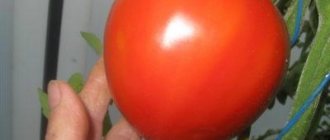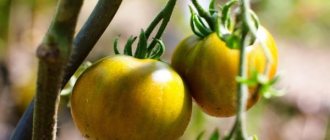Loading…
Loading…
In 2002, an unusual variety of tomatoes appeared on the market, which was developed by a breeder-entrepreneur from Novosibirsk. Later (2006), the Miracle of the Earth tomato was officially included in the State Register of the country. Today, the crop is grown in beds and greenhouses, producing abundant harvests. Seeds are freely sold in specialized retail outlets. And the growing method is accessible even to beginning gardeners.
External features of culture
A detailed description of the variety and characteristics of the Miracle of the Earth tomato allows you to notice all its advantages.
The plant takes root wonderfully throughout almost the entire territory of Europe. It usually takes about 100 days from the appearance of green sprouts to the first fruits. Therefore, it is considered a medium-ripening crop. Standard bushes do not form very dense stems. As a rule, they need support. Under favorable conditions, the tops grow up to 2 m in height. In order for the plant to develop successfully and bear many fruits, only 2 strong shoots are left. The fork is formed just below the first inflorescence. The remaining stepsons are mercilessly removed.
The branches are abundantly covered with medium-sized dark green leaf plates. During the flowering period, buds appear between them, from which fruits are formed. When ripe, they weigh approximately 400 g. However, larger specimens are also found, reaching 1 kg.
The fruits are covered with a thin but quite durable skin. The pulp contains up to 5% dry matter, which includes seeds. When fully ripe, they are used for growing crops. Tomatoes have an excellent sweet and sour taste. In cooking they are used to prepare salads, juice, pasta or all kinds of sauces and dressings.
Tomato fruits of the Miracle of the Earth variety lose their properties during transportation and long-term storage.
On average, the yield of the Miracle of the Earth tomato is approximately 15 kg per 1 m². In southern latitudes, up to 20 kg are collected from the same area. And in cold regions, only 12 kg. The indicators are affected by the culture’s resistance to temperature changes and some diseases. For example, the plant “avoids” late blight, which is considered the worst enemy of tomatoes.
Description
So that gardeners can better understand what the tomato variety Miracle of the Earth is, we will give a detailed description, name the characteristic features of the plant, and include a photo.
A novelty in the world of tomatoes belongs to indeterminate varieties. Tomatoes are intended for growing in open-air garden beds or greenhouses. According to reviews from gardeners who have already planted the Miracle of the Earth tomato for several years in a row in open ground, the yield in the southern regions is excellent. The culture that works best is:
- in the Astrakhan region;
- in the North Caucasus;
- in the Krasnodar region.
But in regions with more harsh conditions, it is better to grow the variety in a greenhouse, despite the fact that the tomatoes are early ripening. A little more than three months pass from the moment of germination.
Bushes
The plant is tall. When grown in open ground, it reaches 1 m 50 cm. In a greenhouse it is much higher - about 180 cm. The plant must be tied to reliable supports. The foliage is medium sized, dark green.
Important! It is because of the height that experienced gardeners advise growing the variety under cover so that the wind does not damage the plant.
The flower stalks are powerful, brush-shaped, with a large number of flowers and then ovaries. Fruit set is excellent. But it can still be stimulated by shaking the bush to enhance pollination. As a rule, up to 10 clusters are formed on a tall bush, on each of which 6-8 fruits subsequently ripen.
Fruit
The fruits of the Miracle of the Earth tomato, as described by the originators, have the shape of a slightly flattened heart, which corresponds to the reviews of those who planted the variety on their site.
The tomatoes are large, on average about 500 grams. The fruits on the first clusters are always larger, often growing up to a kilogram. Please look at the photo below, here is the fruit on the scales.
Fruits with dense sweet pulp, fleshy and sugary at the break. Pink inside. At technical maturity they acquire a bright pink color.
Comment! Ripening occurs over the entire surface; ripe tomatoes of the Miracle of the World variety do not have green spots on the stalk.
The skin on the fruit is dense, so cracking is not observed even in rainy summers. The Miracle of the Earth tomato contains 6 to 8 chambers, with a small number of seeds.
Tomato Miracle of the Earth: advantages and disadvantages of the variety
Growing the crop on their plots, gardeners noticed many advantages.
Let us note just a few points:
- resistance to drought and cold;
- excellent immunity;
- high productivity;
- attractive presentation;
- refined taste;
- rich aroma;
- ripe fruits do not crack.
The disadvantage of the variety is the removal of stepsons during the formation of bushes. Due to the weighty fruits, the plant needs reliable support. It is usually made from wooden stakes or simple structures similar to trellises.
Unfortunately, there are fake Miracle of the Earth tomato seeds on the market that do not correspond to the characteristics of the variety.
Reviews
Reviews about the variety are generally positive, here are some examples:
Tomato-tomato forum
Forumhouse
If you have already tried growing the Miracle of the Earth variety, leave your opinion in the comments under the article, we will be very grateful.
Agrotechnics of cultivation
The culture takes root wonderfully both in open ground and in a greenhouse. Planting material is purchased in specialized stores to obtain an authentic variety.
It is sown in boxes 50 days before the approximate date of transferring the seedlings to the garden according to the following scheme:
- seeds are soaked in warm water for several hours;
- containers are filled with fertile soil;
- using a sprayer, moisten the top layer of soil;
- make shallow holes;
- sow seeds.
Then the containers are taken to a room where the temperature is maintained at approximately +20°C. A film is stretched on top or transparent glass is placed. In about 10 days, shoots will appear. After the appearance of real leaf blades, the bushes are planted in separate pots or containers. When the bushes get stronger, they are prepared for a change in environment.
For 14 days, the seedlings are taken outside and kept for 30 minutes. Gradually the time is increased to 12 hours. Ready for new conditions, seedlings of the Miracle of the Earth tomato variety are transferred directly to the garden bed or to a greenhouse, where they maintain an optimal temperature of +23-25°C. Thanks to this microclimate, self-pollination of the crop occurs.
To get large-sized fruits, 2-3 ovaries are left on each flowering cluster.
Rules for planting in open ground
First of all, prepare the bed. The plowed soil is leveled using a rake. Holes are made at a distance of 70-80 cm from each other. As a rule, 3-4 bushes are placed per 1 m². Approximately 1 liter of water is poured into each hole. Lay out the seedlings at an angle of 45°. Then sprinkle with soil and compact the top layer. Supports up to 2 m high are installed next to the bushes or strong trellises are built.
It is advisable to tie the branches with a thick and wide rope so as not to damage the young shoots.
What care does the Miracle of the Earth tomato need?
Successful cultivation of Miracle of the Earth tomatoes directly depends on timely watering and fertilizing. Humidification is carried out depending on weather conditions. If necessary, young seedlings are watered once a week with 3 liters of liquid for each bush. The procedure is performed after sunset or early in the morning. The next day, the dried soil in the root area is thoroughly loosened, while weeds are removed.
The crop is fed with substances that contain phosphorus, nitrogen and calcium. If possible, use a solution of mullein or chicken manure.
Throughout the season, tomatoes are fertilized 3 times.:
- on the 15th day after planting in an open bed;
- during flowering;
- with gradual ripening of fruits.
In the first month of summer, they begin to form compact bushes. As a rule, they consist of 2 shoots. The densest and most elastic specimens are left. The remaining stepsons, which have reached 8 cm in height, are carefully cut off. If necessary, the procedure is repeated every 10 days in the early morning or evening.
It is advisable to remove stepchildren only before mid-July, so as not to disrupt the development process of tomatoes.
Hilling and applying mulch
Tall crops need a reliable foundation. Therefore, Miracle of the Earth tomatoes are thoroughly hilled at least 3 times. A hill is formed in the root region of the plant. If there is dry, hot weather outside for a long time, cover the soil with mulch. Thanks to this, moisture is retained and weed growth stops.
Used for business:
- straw;
- conifer bark;
- hay;
- sawdust;
- pine needles;
- freshly cut grass.
In addition, mulch protects the plant from cockchafer larvae, which do not like moisture. Tomatoes are not affected by late blight, which significantly increases the yield. If brown spot or tobacco mosaic is found on the bushes, drastic measures are immediately taken. The infected plates are torn off, lubricating the sections with a solution of potassium permanganate.
To treat tomatoes from tobacco mosaic, insecticides “Zaslon” or “Barrier” are used.
Pests
Like all vegetable crops, the Miracle of the Earth variety is sometimes affected by slugs. They get rid of them using wood ash. It is applied to the root zone of the plant. Another worst enemy of tomatoes is the mole cricket. Insects live in small groups in the garden. To get rid of them, the nests are watered with a “fiery” solution. It is made from water and pepper. The crop can be saved from mites by spraying the tops with a soap solution. For 10 liters of water, 100 g of foaming substance is enough. As a last resort, the bushes are treated with chemicals.
The amazing tomato variety Miracle of the Earth is gradually gaining popularity among gardeners. Unpretentiousness to natural conditions allows the crop to be grown almost throughout the country. First, the seeds are sown in containers. The resulting seedlings are transferred to greenhouses (in the north) or to garden beds. Care includes timely watering, fertilizing, and spraying the tops. In about 3-4 months, large pink tomatoes with excellent taste will ripen in the garden.
Pest and disease control measures
Like all other plants, tomatoes are susceptible to some diseases and attacks from harmful insects. The “Miracle of the Earth” tomato has stable immunity to various infectious diseases. The description of the variety prescribes preventive and therapeutic measures for diseases such as:
- Brown spotting.
- Tobacco mosaic.
When fighting tobacco mosaic, infected leaves are removed from the bush, and the cut site is treated with a solution of potassium permanganate. To prevent brown spot, it is necessary to monitor the temperature regime (when grown in greenhouse conditions) and monitor soil moisture. For large affected areas, drugs “Barrier” or “Barrier” .
Harmful insects may include ticks, mole crickets and slugs. You can get rid of slugs by adding ash under the roots of plants. To eliminate mole crickets, you should weed the plantings more often and water the insect nests with a solution of water and pepper. A soap solution will help get rid of the tick. Spraying the bushes with Confidora .










